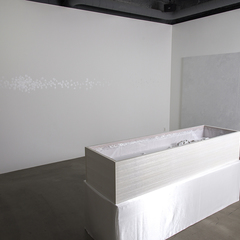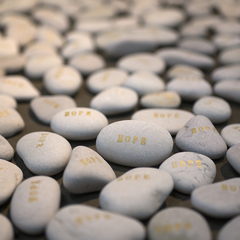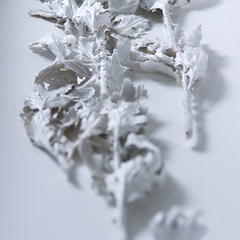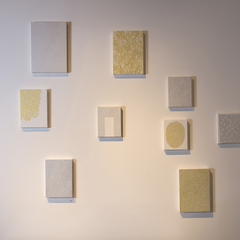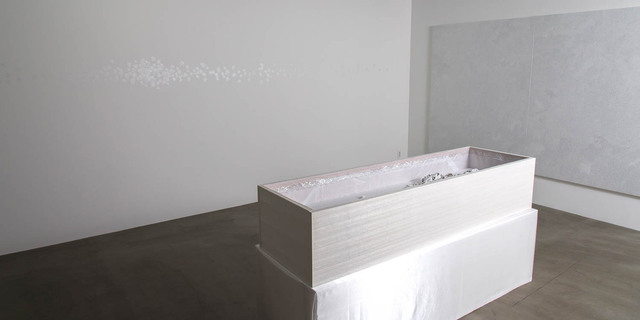
Main Gallery
HOPE
Mariko Noda
2013.11.23 Sat-2013.12.21 Sat
Tezukayama Gallery is pleased to present “HOPE”, a solo exhibition by Mariko Noda from 23. Nov –21. Dec 2013. Noda was born in 1985 in Saga prefecture and she graduated from Kyoto City University of Arts with a BA in Oil Painting in 2009. Since then, she started her carrier as an artist and has been aiming to use a wide variety of media. Her work is seemingly bright and tender. However, hidden beneath the surface is a dark and sometimes even cruel concept.
In 2012, Noda participated in an art festival in Nara prefecture called “ Hanarart”. In this festival, she exhibited with young and energetic artists in ‘The former residence of Kawamoto’, an old Japanese house, which also used to be a brothel. One of her installations works “Locked Them in the Glass (2012)” represented the lives of the girls who used to sell themselves in the house in years gone by. Inside dozens of small glass jars, Noda put brightly coloured water and sprinkled each one with fish scales. Like beautiful fish that cannot escape from their water captivity, these women were prisoners of that colorful and vulgar world.
In May, this year she also participated in “YOUNG ART TAIPEI”, a contemporary art fair in a hotel in Taiwan. She exhibited her painting series “1+1=0” and “Untitled” in which she minutely repeated meaningless units over and over on canvas in order to create meaning in other ways. In this work, one can see Noda’s concept and her spirit with a strong tenacity of purpose shining through the patterns made by the repetition of units to build meaning, shape, and composition.
In her new exhibition ‘Hope’, the theme is built on two Japanese words with the same sound to the ear, but with very different meanings. The themes are ‘death ( 死 shi)’ and ‘poem ( 詩 shi)’. Noda always has strong and clear concepts and this exhibition is no exception. In this work, she expresses a compilation of her thoughts. She celebrates the wonder and complexities of being human and her hope in the human condition, which is capable of so many awful things but can also possess so much power and strength. She rejects the image of death as painful and sad, and in doing so hopes to create a work that is poetic in nature. In this exhibition, we will display her latest large-size painting and installation artwork. We hope you will enjoy this exciting exhibition.
Artist Statement
“Death” has been close to me since I was a little and it always makes me think, “what is human?”, “why do people hurt each other?”.
When I was a high school student, my best friend’s wrist had many marks. Until then, I didn’t know anyone like her and it flustered me so I couldn’t talk about this for a while. One day, I just decided to ask her, “ why did you do hurt yourself?” She answered me directly, “ it feels refreshing” without feeling ashamed. I felt her bottomless sadness and the loneliness in her mind and was frustrated myself that I couldn’t do anything to help her. Perhaps now I create work to express something to her, to understand her.
Since high school, time has passed. Many tragic things have happened and I, again, have felt useless
against them. In Japan, the terrible Tohoku earthquake happened. A large number of people died or were harmed. After the earthquake, I researched wars, serial murders, and the awful things in this world that are the product of people. I thought this was a very important thing for me to do. The world was beyond my imagination. In Japan, there are many terrible and painful things happening. Many awful things are conducted by human beings. On the other hand, there are a lot of positive things that humans can do and can perform amazingly in extreme conditions. This is also an element of the human condition.
I want you to think of both the beauty and the sadness of the human condition that you so often cannot see and think about in your daily life, but that which is right under your very nose every day.
I create artwork to pray for people and believe in people. This work is about ‘Hope’ for those of us who have suffered, who continue to suffer, and ‘Hope’ for the strength and spirit of the human condition.
Mariko Noda
